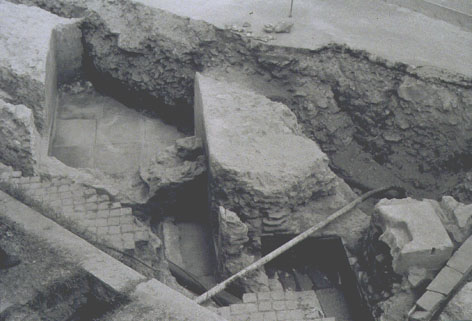
Roman water-mills on the Janiculum Hill, Rome
The project continued with an excavation season from 27th June to 30th
July, 1999, funded by the American Academy, the Packard Foundation, the
Oppenheim Foundation, and the Craven Committee of Oxford University. Excavations
have now ceased and the project is being written up; a preliminary report
(in Italian) appeared in the magazine Forma Urbis in February
2000, and an interim report (in English) will appear in Memoirs of the
American Academy 45 (2001).
 |
Rodolfo Lanciani's sketch of remains of the mill complex seen during road construction in 1886. The sketch shows the Aqua Traiana with two mill races running parallel to it; a series of chambers next to the north (top) mill race are the rooms which originally housed the sets of millstones. |
It was clear from these investigations that the complex consisted of
several mill-wheels installed in two mill-races parallel to the main channel
of the Aqua Traiana, and that the complex extended below the Academy's
car park, but the size of the complex was unknown. Because of the comparative
rarity of known archaeological remains of multiple water-mill installations,
and the evident importance of the mills on the Janiculum in antiquity,
attested by literary and epigraphic references (CIL VI.1711; Regionary
Catalogues; Prudentius, Contra Symmachum II.948-50; Procopius Wars
V.xix.8-9),
further investigation was desirable. In addition, the tentative dating
evidence recovered by Prof. Bell suggested a possible link between the
construction of the mills and the reorganisation of the annona in
the early third century AD, whereby the state shifted from handouts of
grain to distribution of baked bread, and therefore had to assume the responsibility
of grinding the grain (Bell 1992, 1994). Further dating evidence was required,
however, to confirm this hypothesis.
 |
The north millrace of the mills and its return
back towards the Aqua Traiana. On the right hand side is a pit for the
gear wheels to mesh in, and a marble bearing block to support one end of
the axle of a mill wheel. (Photo: M. Bell)
|
| Next | Home |
Go to:
Other Links: